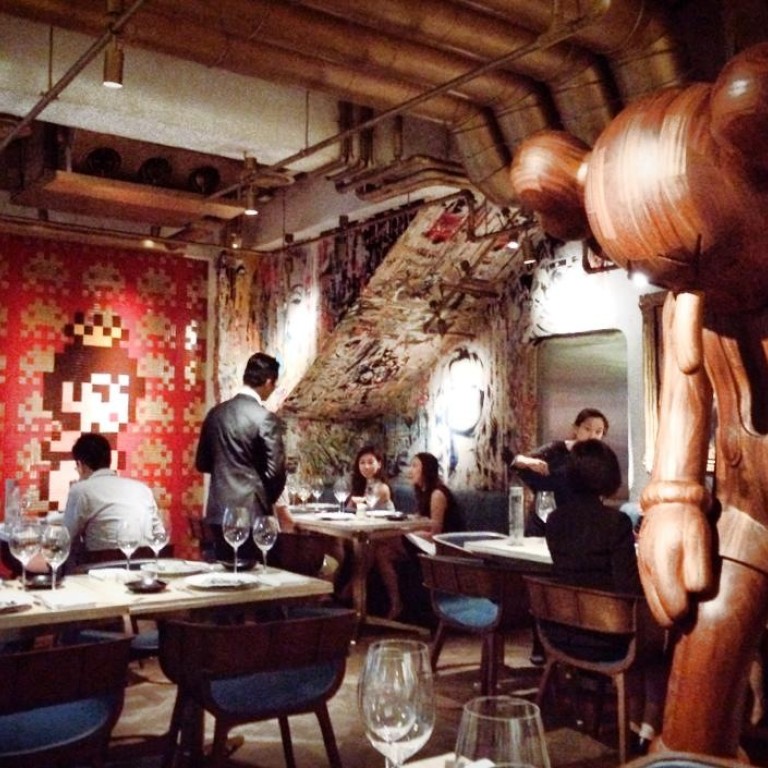
Restaurant reviews: Bibo and Ho Lee Fook
Bibo
As the urban legend goes, a French street artist by the alias Bibo was kicking around in Hong Kong in the 1930s. He took over an abandoned office owned by the tram company and made it a secret hideout for himself and other struggling artists in the city. Some 80 years later, another Frenchman who shares the same penchant for concealed identities opened a restaurant on the west end of Hollywood Road. Named after the enigmatic artist, Bibo is probably the most sought-after and fascinating dining experience to hit Hong Kong this year. It is part art museum and part secret society. Behind the golden sliding door is a stairway that leads to an otherworld, the kind that awaits Alice down the rabbit hole or that Tom Cruise wanders into in Eyes Wide Shut.
At least that’s the aura of mystery the owner intends to create. But even if you don’t buy into the whole who’s-the-wizard-behind-the-curtain gimmick, you should go there for the art collection. While the restaurant has only 14 tables and seats no more than 40 patrons, there is no shortage of artwork that makes your eyes pop. Look to your right and there are pieces by Jeff Koons, Takashi Murakami and Yayoi Kusama. Turn the corner and you are face-to-face with striking murals by Banksy, Space Invader and Jean-Michel Basquiat. That means there is really no bad table at the restaurant – you are surrounded by carefully curated art everywhere you go, giving new meaning to the old adage “you eat with your eyes first.”
Taking the helm in the kitchen is French chef Mutaro Balde, whose CV includes Alain Ducasse in Paris and Robuchon in London. Must-try starters include boiled egg with mayonnaise, pan-seared foie gras with poached rhubarb and Japanese scallops cooked in three ways. For entrées, it is the melt-in-your-mouth pork belly that wins the heart. Avoid the lamb rump, however, because the serving is shockingly small (even if you order the main course size) and the taste is forgettable. Desserts are somewhat over-engineered. Most of them, like the chocolate fondant brownie, look better than they taste.
Dinner for two with wine will set you back just over HK$2,000. The bill is hefty but you get what you pay for: good food, great art and a wonderful time. To make sure all three are delivered to every table, there is an army of impossibly attentive staff in tweed waistcoats and red bowties. They know the menu inside and out and are flat-out passionate about what they do. Restaurant manager Arturo Sims (previously at Principal on Star Street) puts it best: “Bibo is not about the food; it’s not even about the artwork. It’s all about you, our guests.” The old French artist would have been proud.

Ho Lee Fook
Taiwanese Canadian Jowett Yu spent years learning his craft in Australia under the tutelage of Japanese chef Tetsuya Wakuda. Yu now runs two restaurants of his own – Mr. Wong and Ms. G – in downtown and Potts Point Sydney. A few weeks ago, the 32-year-old chef made his first foray in Hong Kong and set up shop in SoHo. He enlisted Douglas Young, founder of G.O.D. and master of cross-cultural puns, to advise on design details (hence the mahjong-tiled kitchen wall and the King of Kowloon calligraphy along the stairs). Young also christened the restaurant Ho Lee Fook, a play-on-word that recalls G.O.D's cheeky tagline "Delay No More."
Let’s start with the food. The fact that the menu is printed in English only and that there is not a Chinese patron in sight should be fair warning to everyone. Just like the restaurant’s name, the dishes are at best quirky and at worst offensive. Basic items like spring rolls and pork dumplings are subpar even by Westernised Chinese food standard. The more adventurous options, like the duck egg and tomato salad and steamed rice with seaweed and pork floss, are just as underwhelming. To be fair, the Wagyu short ribs and grilled pork belly are actually decent, if only the meat weren’t drenched in oil. You can't help but wonder: is this the kind of Chinese food people eat in Australia?
The décor also raises eyebrows. The dining area is in a windowless basement of untreated grey walls and faux black leather sofas. Combined with the low ceiling and exposed air ducts, the place feels cheap and claustrophobic. It is a far-cry from the “New York Chinatown night club” feel that the owner is going for. Meanwhile, earsplitting rock music blasts from the loudspeakers, making it impossible to have a conversation – or to lament how you have just spent HK$400 on a dinner you would rather forget.
Jowett Yu might have survived and even excelled in Australia, but flukes don’t do well here. The Hong Kong food scene is hyper-competitive if not altogether cruel. Hype and the forgiving expat community can carry a restaurant only so far, before the city chews it up and spits it out. Unless Yu does some soul searching and rethinks his cooking, Ho Lee Fook won’t last more than 18 months – that’s typically when our patience runs out. The young chef is well advised to take a short walk to the nearby dai pai dong or siu chao [stir-fry] kitchens and get some lessons from the real masters there.
The views are the author's own.

